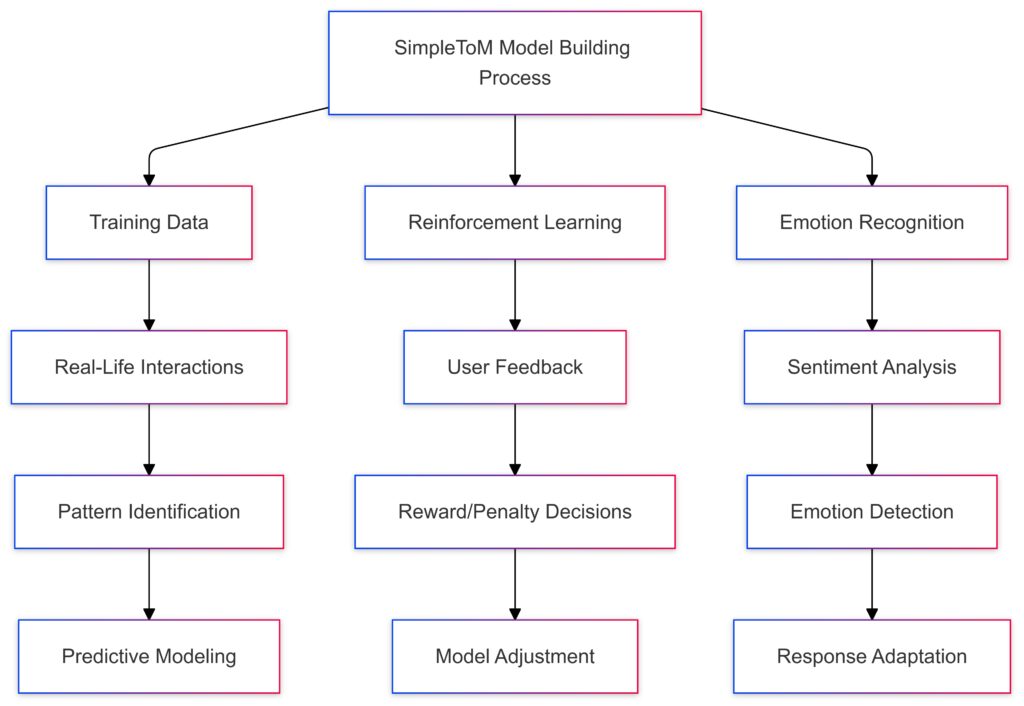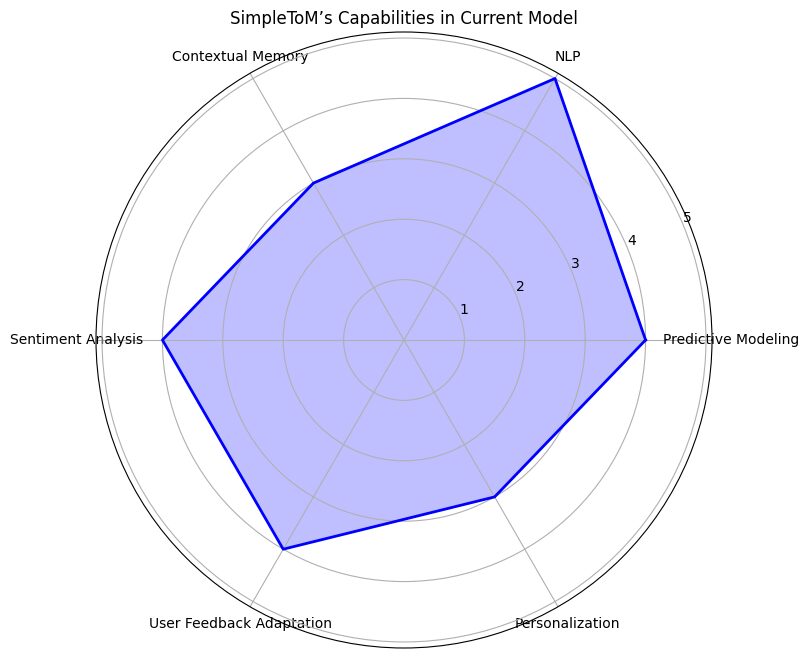
One of the most compelling advancements in teaching machines, is to understand human intent. SimpleToM, short for Simple Theory of Mind, is an emerging AI approach focused on interpreting human intentions and motivations.
This shift has profound implications for AI’s ability to interact naturally with users and make intuitive, helpful decisions.
What Is Theory of Mind in AI?
Understanding Theory of Mind
In psychology, Theory of Mind (ToM) is the ability to attribute beliefs, desires, and intentions to others. When applied to AI, Theory of Mind means teaching machines to understand the thoughts and motivations behind user actions. Traditional AI models respond to commands, but Theory of Mind models predict why a user might want a specific outcome, helping AIs to engage with more empathy and insight.

Why Theory of Mind Matters in AI Development
AI has traditionally been limited to logic-driven tasks. However, as AIs become more integrated into customer service, education, and healthcare, understanding human motivations is crucial for delivering personalized experiences. Models with ToM can adapt to situations like a customer’s frustration or an online learner’s confusion, enhancing the human-AI interaction.
SimpleToM: A Simplified Approach
SimpleToM focuses on this Theory of Mind concept but keeps it streamlined and efficient. Unlike complex ToM systems that require massive data sets and intricate algorithms, SimpleToM uses simplified models to infer intent, offering a scalable, cost-effective solution without sacrificing depth of understanding.
How SimpleToM Is Built: Key Components
Training Data Focused on Real-Life Interactions
For an AI to understand human intent, it needs data. SimpleToM developers gather data from real-life scenarios like customer interactions, social media exchanges, and helpdesk queries. This helps create a model trained on varied human responses, crucial for accurate intent prediction. By learning from these everyday interactions, SimpleToM models can identify patterns in behavior.
Using Reinforcement Learning for Continuous Improvement
Once initial training is complete, reinforcement learning techniques kick in. In this setup, SimpleToM improves by “learning” from its successes and mistakes. For instance, if the model correctly interprets a user’s intent to be frustrated, it gets a reward. But if it misinterprets a calm request as frustration, it’s marked for improvement. Reinforcement learning keeps SimpleToM models sharp and adaptive.
Emotion Recognition Through Sentiment Analysis
Emotion recognition is another critical part of SimpleToM. With sentiment analysis, SimpleToM deciphers emotional cues from text, voice, or other input forms. For example, a message saying, “This is the third time I’m asking for help,” signals frustration. SimpleToM can then adjust its response to address the frustration directly, making the conversation more relevant and sensitive.

Reinforcement Learning: Flows from user feedback to reward/penalty decisions and model adjustment.
Emotion Recognition: Starts with sentiment analysis, progressing to emotion detection and response adaptation.
Building SimpleToM Models to Mimic Human Cognition
Mimicking Empathy Through Predictive Modeling
SimpleToM doesn’t just respond to commands; it predicts user needs, almost like a digital empathy mechanism. Predictive modeling allows it to anticipate user questions and concerns. For example, if a customer is asking about delayed shipments, SimpleToM can sense they may be upset and respond proactively with empathetic language, creating a more supportive experience.
Implementing Natural Language Processing for Nuanced Understanding
Natural Language Processing (NLP) is at the heart of SimpleToM’s intent comprehension. NLP helps models understand slang, sarcasm, and nuanced language. For example, if someone says, “Great, just what I needed!” sarcastically, SimpleToM identifies the context and tone to respond appropriately.
Contextual Memory for Long-Term Engagement
SimpleToM models utilize contextual memory to retain details from prior interactions, similar to how humans remember past conversations. This allows SimpleToM to build ongoing relationships with users by recalling preferences and previous problems, which enhances user trust and comfort in their interactions.

Axes: Each axis represents a specific capability in the SimpleToM model, such as Predictive Modeling and Sentiment Analysis.
Values: Indicates the level of development (1 to 5) for each capability, with higher values showing more developed features.
Real-World Applications of SimpleToM AI

Enhancing Customer Service Experiences
In customer service, SimpleToM’s understanding of human intent helps resolve issues faster by adapting responses based on user emotion and context. If a customer’s tone suggests frustration, the model can prioritize their query or suggest personalized solutions, resulting in smoother service.

Applications:Customer Service: Includes Personalized Responses and Proactive Assistance.
Healthcare: Features Patient Emotion Tracking and Predictive Health Alerts.
Education: Offers Adaptive Learning Paths and Student Sentiment Monitoring.
Transforming Virtual Health Support
In healthcare, having AI that understands intent can make a significant impact. For instance, a patient describing symptoms with anxiety may benefit from reassurance, not just data. SimpleToM can recognize these subtle cues and offer supportive guidance beyond the basics, improving the patient’s comfort and trust in virtual care.
Improving Interactive Learning Platforms
For online learning platforms, SimpleToM models can enhance student engagement by identifying when a learner is confused or losing interest. By adapting teaching methods based on detected frustration or excitement, SimpleToM helps make learning more personalized and effective.
The Challenges in Developing SimpleToM Models
Balancing Sensitivity and Privacy
One of the primary challenges in designing SimpleToM models is balancing sensitivity to user emotions with privacy. Because SimpleToM relies on understanding user emotions and intentions, it requires data that often includes personal interactions and preferences. Ensuring data privacy and protecting sensitive information is essential, and developers have to strike a balance between insight and ethical data handling.

Cultural Sensitivity: Tackled through Cultural Context Training and to a lesser degree by Data Anonymization.
Ambiguity of Language: Managed through NLP Refinement and minor emphasis on Cultural Context Training.
Managing Cultural and Individual Differences
SimpleToM needs to recognize that human intentions vary widely across cultures and individuals. For instance, a raised voice might signify frustration in one culture, while in another, it could simply reflect enthusiasm. Training models to be aware of these distinctions is critical for accurate and respectful responses. Misinterpretations can lead to user dissatisfaction, making it vital for SimpleToM to consider both cultural context and personal preferences.
Navigating the Complexity of Ambiguous Language
Human language is full of ambiguities and nuances—for example, sarcasm, idioms, or playful language. Training SimpleToM to recognize these subtleties is challenging, as these instances often require an understanding beyond literal words. Developers must constantly refine the model’s language processing capabilities, aiming to minimize errors in tone detection and sentiment analysis to avoid misunderstandings.
Ethical Considerations in Intent Recognition
Ensuring Transparent AI Interaction
As SimpleToM becomes better at interpreting intent, it’s essential that users are aware they’re interacting with an AI. Transparent communication about AI’s presence can prevent misleading situations and help users maintain trust. Ensuring that AI interactions feel natural yet clearly identifiable as non-human is key to ethical AI deployment.
Avoiding Over-Personalization
While personalization improves user experience, too much familiarity from AI can feel invasive. If SimpleToM recalls too many personal details or adapts too closely to a user’s emotional state, it may raise privacy concerns. Developers must consider the ethical implications of creating a balance where users feel understood but not overly monitored.
Preventing Unconscious Bias in Model Responses
Bias in AI remains a pressing concern, particularly for models designed to interpret emotions and intentions. SimpleToM is at risk of unintentionally mirroring societal biases if the training data isn’t carefully selected and diversified. Regular auditing of the model’s responses can help mitigate bias, but it remains an ongoing challenge in creating truly unbiased intent recognition.
The Future of SimpleToM and Human-AI Interaction
Advancing Toward Intuitive AI
The future for SimpleToM lies in developing even more intuitive, responsive AI models that can understand human behavior in nuanced ways. As technology advances, we may see SimpleToM evolve to recognize body language or subtle vocal cues, enhancing its comprehension of human intent to an impressive level of sophistication. Such advancements could push SimpleToM further into fields like therapy, personal coaching, and complex negotiations.
Expanding Applications in Virtual Reality and the Metaverse
SimpleToM has promising potential in the metaverse and virtual reality. These immersive environments require AI to handle social interactions with heightened subtlety and context. SimpleToM could enable more realistic virtual interactions by recognizing user emotions in real time, adapting to personal preferences and social cues, and adding a new dimension of connectivity in digital spaces.
Building Collaborative Human-AI Relationships
SimpleToM aims to foster mutually beneficial relationships between humans and AI, where the technology doesn’t merely assist but collaborates. Imagine AI co-workers that understand team dynamics, or teaching assistants that adjust to each student’s unique learning style. The future of SimpleToM envisions AIs that enhance human potential, not only through automation but by enhancing connection and cooperation.
SimpleToM stands at the exciting intersection of human psychology and AI technology, poised to revolutionize how we interact with machines. With careful ethical considerations and technical refinements, this innovative approach may soon bring us into a world where AIs are more than tools—they become partners in understanding and navigating our world.
FAQs
How does SimpleToM differ from traditional AI models?
Traditional AI models typically respond to straightforward commands and rely heavily on literal interpretation. SimpleToM, however, interprets the motivations and emotions behind these commands. This approach makes SimpleToM adaptable in situations where context, empathy, and emotional cues matter, such as in customer support or virtual learning environments.
Why is reinforcement learning important for SimpleToM?
Reinforcement learning allows SimpleToM to learn from its successes and mistakes, improving its responses over time. By continuously adjusting its behavior based on user feedback, SimpleToM grows more accurate in identifying user intent, making it a self-improving system that gets better with ongoing use.
Can SimpleToM be used in sensitive fields like healthcare?
Yes, SimpleToM’s intent recognition makes it ideal for sensitive fields like healthcare. It can recognize emotional cues, such as anxiety or frustration, helping healthcare providers respond with empathy and precision. However, maintaining privacy and upholding ethical standards are crucial when implementing SimpleToM in such areas.
How does SimpleToM handle ambiguous language?
SimpleToM uses Natural Language Processing (NLP) to interpret nuances, sarcasm, and idioms that often carry hidden meanings. It’s designed to analyze context to understand a user’s true intent even when language isn’t straightforward, which reduces misinterpretations and enhances conversational accuracy.
What measures are in place to address bias in SimpleToM?
To prevent unconscious bias in SimpleToM’s responses, developers use diverse datasets and regularly audit model performance. By monitoring and refining SimpleToM’s training processes, teams work to ensure the model delivers unbiased, respectful interactions across various social and cultural contexts.
How does SimpleToM ensure user data privacy?
User privacy is a priority in SimpleToM’s design. SimpleToM models are developed with strict data handling protocols that anonymize personal information and comply with data protection regulations. This approach ensures that user interactions remain confidential while still allowing the AI to learn from generalized patterns.
Where is SimpleToM likely to have the most impact in the future?
SimpleToM has the potential to make a significant impact in customer service, education, healthcare, and virtual environments like the metaverse. As it becomes more adept at understanding intent, SimpleToM can improve experiences in these areas by making AI more empathetic, responsive, and adaptive to human needs.
How does SimpleToM anticipate user needs?
SimpleToM uses predictive modeling to anticipate user needs based on past interactions and contextual clues. By analyzing patterns in user behavior, SimpleToM can provide proactive assistance, such as offering helpful suggestions before a user explicitly asks. This allows for a smoother, more supportive user experience that feels naturally attentive.
Is SimpleToM adaptable across different languages and cultures?
Yes, but it requires careful localization and training for each language and cultural context. SimpleToM can be customized to understand cultural nuances and adapt its responses accordingly, which is crucial for maintaining respect and accuracy in diverse interactions. This adaptability is achieved by training the model with region-specific data and language variations.
How does SimpleToM handle user frustration or dissatisfaction?
SimpleToM is trained to recognize negative emotions like frustration through sentiment analysis, allowing it to adjust its responses with empathy and concern. When frustration is detected, SimpleToM can modify its language to be more reassuring, escalate the issue more quickly, or offer alternative solutions, improving the likelihood of a positive outcome.
Does SimpleToM have memory capabilities for long-term interactions?
Yes, SimpleToM employs contextual memory to retain key details from previous interactions, allowing it to reference past conversations or user preferences. This memory feature is especially useful in applications like customer support, where continuity and a sense of personal attention can significantly enhance user satisfaction and loyalty.
What safeguards exist to prevent SimpleToM from overstepping in personalization?
To avoid over-personalization, SimpleToM is designed with adjustable parameters for personalization depth, allowing companies to control how much user data the AI retains and uses. These safeguards ensure that users feel understood without feeling that their privacy is compromised or that the AI is overly intrusive.
Is it possible to integrate SimpleToM with existing AI systems?
Yes, SimpleToM can be integrated with existing AI frameworks, such as customer support chatbots or virtual teaching assistants. With its modular design, SimpleToM can be layered onto established systems to enhance intent recognition and empathetic response, making it a versatile addition to a wide range of AI applications.
Can SimpleToM interpret body language or tone in spoken language?
Currently, SimpleToM is focused on text-based interactions, but ongoing developments aim to expand its capabilities to interpret tone and body language in voice and video interactions. As this technology advances, SimpleToM will be able to detect vocal inflections or non-verbal cues, adding another layer of understanding to its interactions.
How does SimpleToM handle complex scenarios where intent is unclear?
When faced with ambiguous intent, SimpleToM is trained to ask clarifying questions or offer multiple response options. This approach minimizes miscommunication and empowers the user to guide the conversation toward their desired outcome. In more intricate cases, SimpleToM can also refer users to human support for further assistance.
What are the biggest limitations of SimpleToM?
The main limitations of SimpleToM include its reliance on high-quality, diverse training data and the challenges of accurately interpreting complex human emotions and intentions. Additionally, achieving true intent understanding is still an evolving field in AI, which means SimpleToM will continue to improve with technological advancements but may face nuanced limitations in empathy and cultural understanding.
Resources
Research Papers and Articles
- Building Machines That Learn and Think Like People by Josh Tenenbaum et al., published in Science
Explores the cognitive science foundations of Theory of Mind, a key concept in SimpleToM and similar AI models. - The Theory of Mind Model in Artificial Intelligence: An Analysis published in Frontiers in Psychology
Covers the psychological and technical approaches used to implement Theory of Mind in AI, including intent and empathy modeling. - Learning from User Interactions for Emotional AI by Rosalind Picard et al., available through IEEE Xplore
A paper focused on how reinforcement learning can be applied to enhance emotional understanding and adaptability in AI.
Online Courses and Tutorials
- DeepLearning.AI’s Natural Language Processing Specialization on Coursera
This course series introduces NLP concepts like intent recognition, sentiment analysis, and contextual memory, central to AI like SimpleToM. - CS50’s Introduction to Artificial Intelligence with Python by Harvard University
Covers core AI concepts, including machine learning and NLP, which are essential for developing intent-based AI models. - Ethics and Governance of Artificial Intelligence by the University of Helsinki
A free course on the ethical and governance challenges in AI, especially relevant for handling privacy and bias in human-interactive models.